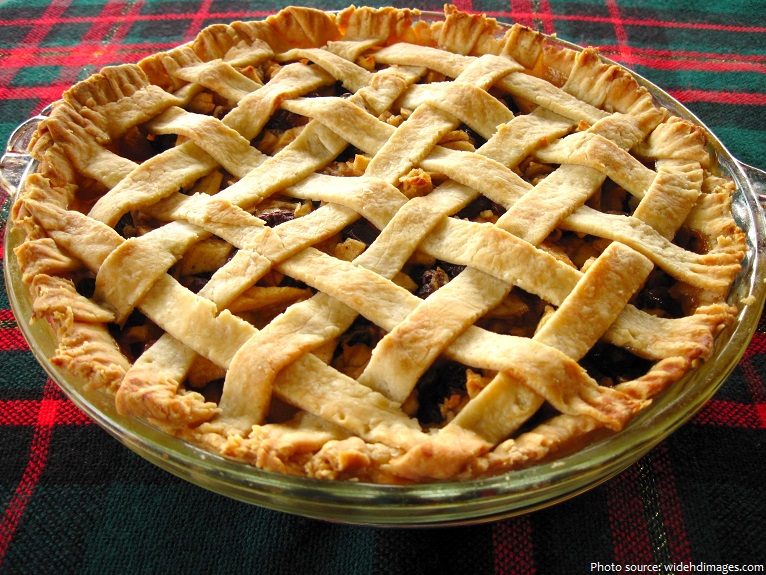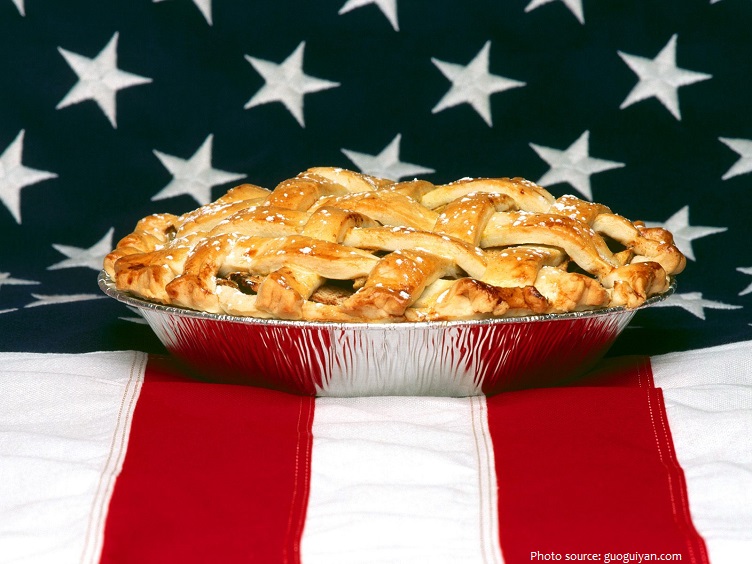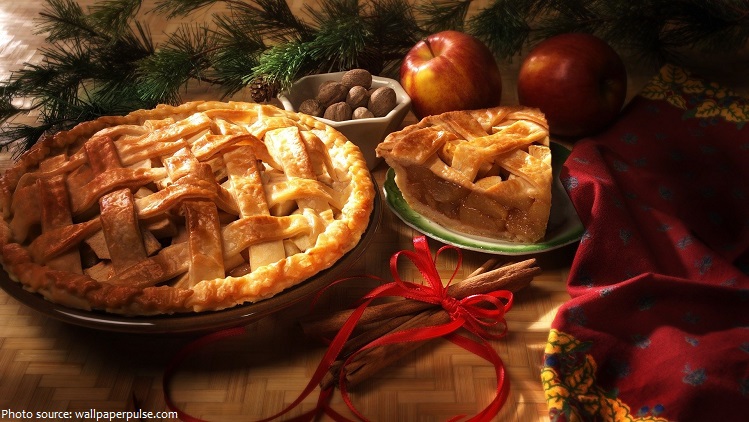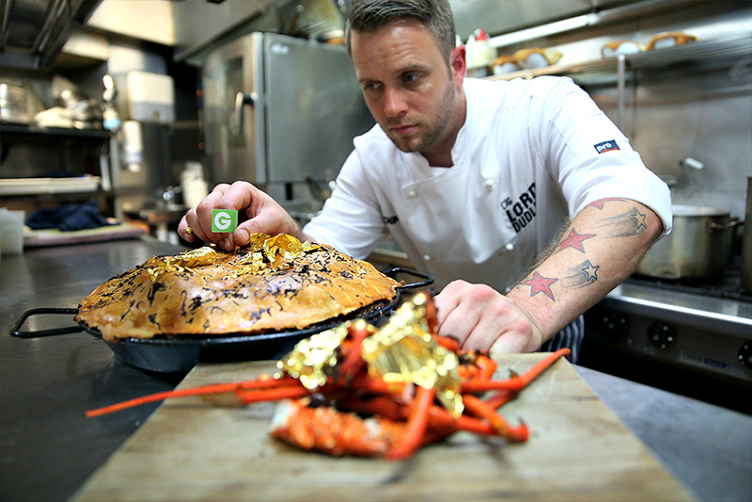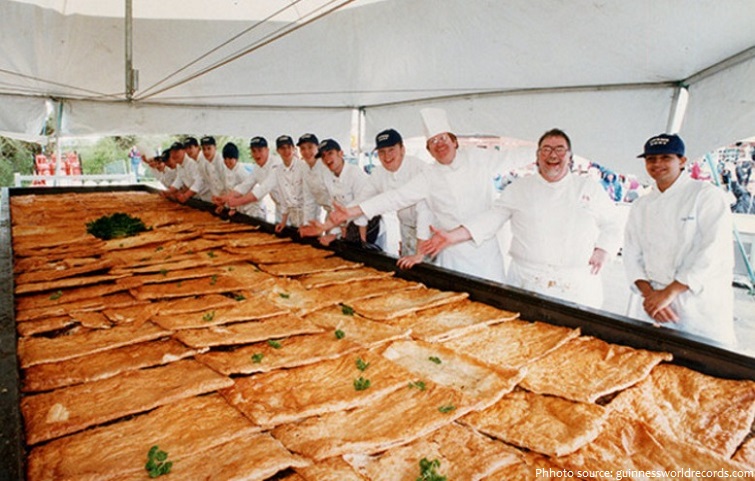A pie is a baked dish which is usually made of a pastry dough casing that covers or completely contains a filling of various sweet or savoury ingredients.
Historians have recorded that the roots of pie can loosely be traced back to the ancient Egyptians during the Neolithic Period or New Stone Age beginning around 6000 BC.
The bakers to the pharaohs incorporated nuts, honey, and fruits in bread dough, a primitive form of pastry. Drawings of this can be found etched on the tomb walls of Ramses II, located in the Valley of the Kings. Ramses II ruled from 1279 to 1213 BC.
Historians believe that the Greeks actually originated pie pastry. In the plays of Aristophanes (5th century BC), there are mentions of sweetmeats including small pastries filled with fruit.
The Romans, sampling the delicacy, carried home recipes for making it (a prize of victory when they conquered Greece).
The 1st-century Roman cookbook Apicius makes various mentions of recipes which involve a pie case. By 160 BC, Roman statesman Marcus Porcius Cato (234–149 BC), who wrote De Agri Cultura, notes the recipe for the most popular pie/cake called placenta.
With the development of the Roman Empire and its efficient road transport, pie cooking spread throughout Europe.
The first reference to “pyes” as food items appeared in England (in a Latin context) as early as the 12th century, but no unequivocal reference to the item with which the article is concerned is attested until the 14th century (Oxford English Dictionary sb pie).
The Pilgrim fathers and early settlers brought their pie recipes with them to America, adapting to the ingredients and techniques available to them in the New World. Their first pies were based on berries and fruits pointed out to them by the Native North Americans.
Over the years, pie has evolved to become what it is today “the most traditional American dessert”. Pie has become so much a part of American culture throughout the years, that a saying “as American as apple pie“ is now commonly use.
The typical American pie is round, 20–25 cm (8–10 inches) in diameter, 5–8 cm (2–3 inches) thick, and usually contains a sweet filling of fruit, custard, or a pastry cream.
Pies can be made either “one-crust,” where the filling is placed in pastry dough and baked without a top crust or “two-crust,” with the filling completely enclosed on top and bottom within the pastry shell.
Apple pie is the most popular flavor in America, followed by pumpkin, chocolate, lemon meringue and cherry – according to the American Pie Council.
Apple pie was brought to the colonies by the British, Dutch, and Swedes during the 17th and 18th centuries. The apple pie had to wait for the planting of European varieties, brought across the Atlantic, to become fruit-bearing apple trees, to be selected for their cooking qualities as there were no native apples except crabapples, which yield very small and sour fruit.
The pumpkin is a symbol of harvest time, and pumpkin pie is often eaten during the fall and early winter. In the United States and Canada, it is usually prepared for Thanksgiving and Christmas, and is also featured at Halloween.
The world’s most expensive pie was designed at the Lord Dudley Hotel in Sydney and is worth AU $12,000 – about USD $9,500. Ingredients include two cuts of premium beef, two whole rock lobsters, rare winter black truffles, two bottles of Penfolds Grange Reserve and pastry with 24k German gold leaf.
The world’s largest pie (meat pie) weighing 10,540 kg (23,237 lb) was made by 17 catering students from Stratford-upon-Avon College, Warwickshire, UK at the Hand Stadium, Clevedon, Somerset, UK on April 1998. The pie was made in a container measuring 9.75 m (32 ft) long, 2.32 m (7 ft 7 in) wide and 0.61 m (2 ft) deep.
The longest line of pie slices is 318.5 m (1,044.95 ft) and was achieved by Malopolska OrganizacjaTurystyczna (Poland), in Szczawnica, Poland, on 24 April 2016.
Naader Reda ate 32 slices of pumpkin pie in 30 minutes. They are equivalent to four 20-centimeter (8-inch) whole pies weighing a total of 4.3 kilograms (9.48 pounds).
Throwing a pie in a person’s face has been a staple of film comedy since the early days of the medium, and real-life pranksters have taken to targeting politiciansand celebrities with their pies, an act called “pieing.”
The first known pie fight appeared in 1909’s Mr. Flip, in which an obnoxious general store manager gets his comeuppance in the form of a pie to the face. Though the film itself is forgettable, other filmmakers of the time were inspired by the pie throwing scene—a visual gag perfectly suited to the then-soundless medium. Almost instantly, the pie fight became a staple of silent films.
The world record for the largest custard pie fight is 253 people gathering to throw 648 pies in a matter of minutes. The record was achieved in Colchester, Essex, UK on 13 august 2009.
The largest shaving cream pie fight consists of 1,180 participants and was achieved by Another Fine Fest (UK) in Ulverston, UK, on 18 June 2016.
Since the Middle Ages, the city of Gloucester has sent monarch pies containing lampreys (a sort of
eel) to celebrate royal events.
In “A Winter’s Tale” Shakespeare gives a recipe for a warden pie, which includes mace, nutmeg, ginger, prunes, raisins and saffron to colour it.
“Eat humble pie” meaning act submissively and apologetically, especially in admitting an error. The phrase was originally derived from a 14th century pastry containing ‘numbles’ or ‘umbles’ (organs and entrails of animals). As these pies were generally consumed the poor, it’s assumed that the idiom either evolved naturally (or by allusion) drawn from similarity to the word ‘humble’.
“As easy as pie” is an American expression. Back in the 1890s ‘pie’ was a common slang expression meaning anything easy, a cinch; the expression easy as pie stemmed quite readily from that.
“If you want to make an apple pie from scratch, you must first create the Universe.” — Carl Sagan


